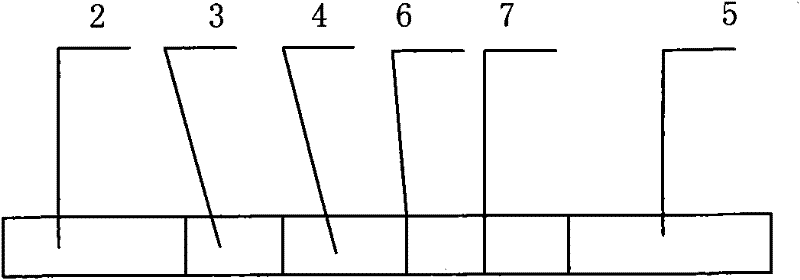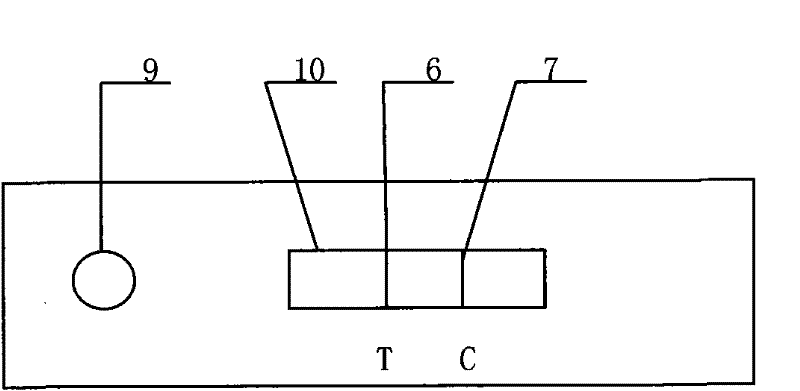Enterovirus 71 antigen detection test strip (colloidal gold method)
An antigen detection and enterovirus technology, applied in the field of biomedicine, can solve the problems of changes in amplification efficiency, high RT-PCR requirements, and unsatisfactory problems, and achieves high specificity and sensitivity, good repeatability, and rapid detection.
- Summary
- Abstract
- Description
- Claims
- Application Information
AI Technical Summary
Problems solved by technology
Method used
Image
Examples
example 1
[0048] Preparation of gold-labeled pads of colloidal gold-labeled rabbit anti-EV71 virus antigen polyclonal antibodies.
[0049] 1.1. Preparation of gold-labeled antibodies
[0050] 1.1.1 Preparation of colloidal gold: A well-known citric acid reduction method is used to obtain colloidal gold particles with a particle size of about 40 nanometers.
[0051] 1.1.2 Preparation of EV71 virus polyclonal antibody: After purification of EV71 lysate from cell culture (provided by CDC virus disease), New Zealand white rabbits were immunized multiple times. When the titer of ELISA was greater than 1:20000, the rabbit blood was collected, and serum was collected overnight at 4°C. , after purification by Protein A column affinity chromatography, the finished rabbit anti-EV71 virus polyclonal antibody was obtained.
[0052] 1.1.3 Preparation of gold-labeled antibody: Add 1-5 mg of polyclonal antibody prepared in 3.1.2 to 100 ml of colloidal gold solution; then add 10 ml of 10% sodium chlor...
example 2
[0056] Example 2. Preparation of enterovirus type 71 antigen gold-labeled test strips
[0057] 2.1 Cut the above-mentioned colloidal gold pad, sample pad and absorbent paper into suitable long strips according to the size of the substrate and the chromatography membrane on the substrate.
[0058] 2.2 Paste the colloidal gold pad on the side of the detection line of the chromatographic membrane on the substrate, with an overlap of 1-2mm with the chromatographic membrane.
[0059] 2.3 Align one side of the sample pad with the edge of the substrate, and cover the other side with a 2mm colloidal gold pad and paste it on the substrate.
[0060] 2.4 Paste the absorbent paper on one side of the chromatographic membrane quality control line on the bottom liner, overlapping with the chromatographic membrane by 1-2mm, to make a gold-labeled reagent card.
example 3
[0061] Example 3. Cutting
[0062] 3.1 First, paste a layer of protective film on the sample pad and absorbent paper at both ends of the gold-labeled reagent card, and then use a film cutter to cut the gold-labeled reagent card into test strips with a width of 2-4mm, and put them in the test strips with desiccant. Seal in an aluminum foil bag and store at room temperature 2-30°C.
[0063] 3.2 It is also possible to cut the gold-labeled reagent card directly with a film cutter into test strips with a width of 2-4mm without the protective film. Seal in an aluminum foil bag and store at room temperature 2-30°C.
PUM
| Property | Measurement | Unit |
|---|---|---|
| particle diameter | aaaaa | aaaaa |
Abstract
Description
Claims
Application Information
 Login to View More
Login to View More - R&D
- Intellectual Property
- Life Sciences
- Materials
- Tech Scout
- Unparalleled Data Quality
- Higher Quality Content
- 60% Fewer Hallucinations
Browse by: Latest US Patents, China's latest patents, Technical Efficacy Thesaurus, Application Domain, Technology Topic, Popular Technical Reports.
© 2025 PatSnap. All rights reserved.Legal|Privacy policy|Modern Slavery Act Transparency Statement|Sitemap|About US| Contact US: help@patsnap.com



